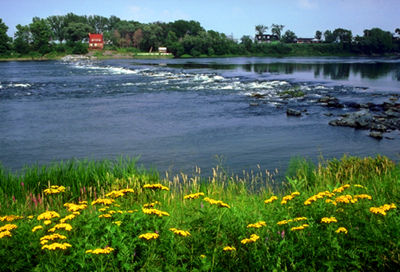Sorel-Tracy, Quebec, incorporated as a city in 2000, population 35,165 (2021 census), 34,755 (2016 census). Sorel-Tracy is located on the south shore of the St. Lawrence River, at the mouth of the Richelieu River, approximately 80 km northeast of Montreal. Sorel-Tracy is the result of the voluntary amalgamation of the municipalities of Sorel (founded in 1642) and Tracy (incorporated in 1954) in 2000. Sorel-Tracy is known for its industrial port and metallurgy industry.
History of Sorel
Sorel was the fourth oldest city in the province of Quebec. Pierre de Saurel, a captain in the Carignan-Salière Regiment, gave his name to the seigneury granted in 1672. In 1781, Sir Frederick Haldimand, the governor of Quebec, built a manor on the Richelieu River, later used as a summer residence for governors general of Canada. He made plans to build a town he hoped would be populated by Loyalists. However, few such settlers came to the area. From 1787, the town was called William Henry, after a son of George III. It was renamed Sorel in 1860, the spelling slightly changed from that of the seigneury. In 1784, the first Anglican mission was established there.
In the mid-19th century, the rapidly growing town was a terminal for river shipping originating in Champlain Lake and profited from the trade between Montreal and Quebec City. The lumber industry and shipyards also prospered, allowing Sorel to receive municipal status in 1889. In the Second World War, as a centre for wartime industry, it employed 20,000 workers. Shipbuilding and heavy industry were its principal activities. It also had textile plants, clothing, plastics, concrete and light manufacturing industries. Sorel remained a busy year-round seaport and the commercial centre for agriculture in the Richelieu Valley.
History of Tracy
Formerly known as the municipal parish of Saint-Joseph-de-Sorel, the name Tracy was adopted in 1954 when it was incorporated as a town. This was to honour Alexandre de Prouville, Marquis de Tracy, the successful military governor of New France (1663-1967), who built a fort near the present site. The Tracy region was part of a seigneury granted in 1672 to Pierre de Saurel, although some small-scale European settlements existed here prior to this date. Following the American Revolution, some United Empire Loyalists settled in Tracy.
In the late 19th century, increasing industrialization, including some shipbuilding, was accompanied by rapid population growth. A brief but severe economic recession set in after the Second World War, for which Tracy's industries churned out large quantities of military material. However, in the 1950s, a construction boom and spreading urbanization swelled the population base. The iron, steel and titanium industries were the major forms of economic activity and the largest single employers in the city. Tracy's development was linked closely with the shipbuilding economy of nearby Sorel.
A major archaeological discovery in 1961 produced fine examples of Iroquoian pottery, tools and weapons which pre-date European colonization.

 Share on Facebook
Share on Facebook Share on X
Share on X Share by Email
Share by Email Share on Google Classroom
Share on Google Classroom


